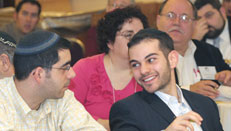 |
||||||||||||
| Weekly Parsha | ||
| Current Week | ||
| Parsha Archives | ||
| Business Ethics | ||
| Dr. Malamet Speaks Out | ||
| TiM MP3 Library | ||




A Thought for the Week with Rabbi Jay Kelman
|
 The shalosh regalim of Pesach, Shavuot and Sukkot are a celebration of great historic events coupled with the recognition of G-d's role in our agricultural success. Even if the land of Israel experiences drought and the like, the knowledge that G-d controls nature is quite comforting. These three pilgrim festivals, with their deep ties to the land, resonate differently in the land of Israel than they do in the Diaspora. Hence it is not surprising that, in practice, the length of the festival is different depending on whether or not one resides in the land of Israel . The holidays of Rosh Hashanah and Yom Kippur, which focus on the individual and do not appear related to agricultural events, have no such distinction. However, this picture is not fully accurate. There is no historical event-at least as far as the Biblical text is concerned-associated with Shavuot. The date of Divine revelation is never mentioned in chumash and no doubt this is a deliberate omission. "Each and every day they should be in your eyes as new, as if you received them today from Mount Sinai" (Rashi, Shemot 19:1). Each and every day is the day to celebrate the receiving of the Torah. Had the Torah chosen a specific day to celebrate our receiving of it, we would run the risk of lessening its importance on all the other days of the year. Furthermore, the Torah we received on Shavuot did not fare very well. The covenant established between G-d and the Jewish people lay in tatters a mere forty days afterwards, and it took Moshe eighty days of pleading to "convince" G-d to make a second covenant with the Jewish people. The date of that covenant-also never mentioned in the Torah-was Yom Kippur (Ta'anit 30b). In the Torah, Shavuot is referred to only in agricultural contexts: "and the feast of the harvest [of] the first fruits of your produce" (Shemot 23:16), "and the holiday of weeks through the first fruits of your wheat harvest" (34:22). The Talmud (Megillah 30b) rules that the Torah reading on Shavuot is not the aseret hadibrot (the "ten commandments") as we do today, but rather "count seven weeks, from the time that you first put the sickle to the standing grain you must count seven weeks" (Devarim 16:9). Why then is Shavuot celebrated as zman matan torateinu , the time of the giving of our Torah? One of the many challenges facing the Jewish people upon the destruction of the Temple was how to maintain the relevance of the entirety of Torah when so much of it was no longer applicable. The brilliance of the Rabbis manifested itself (among many other ways) in their ability to conceptualize and turn those mitzvoth which could no longer be observed physically into eternal values, while at the same time instilling the notion that these values are meant to complement the actual mitzvah. Our prophets had already alluded to this in their understanding of korbanot by constantly reminding us that sacrifices are only a means to an end, though both the means and the end are important. Without sincere worship of G-d, without extra compassion towards the poor, the stranger and the orphan, korbanot are no more (and perhaps a lot less) than meaningless empty ritual. Our Sages instituted many a law (for example, taking the lulav and etrog for the entire holiday of Sukkot) to keep the memory of the Temple vividly in our consciousness. We are never to lose sight of the fact that without the Temple , Jewish life can never be complete. Shavuot presented the Rabbis with a most difficult dilemma. How does one celebrate an agricultural holiday when one has no land? To focus on the land would add sadness to what the Torah mandates as a day of joy. The Rabbis, in their infinite wisdom, found new meaning by associating Shavuot with the receiving of the Torah. Although it was downplayed by the Torah text, Revelation did in fact occur at this time. This association was not merely a new theme on an old holiday. Rather our Sages wanted to call our attention to the fact that the Torah of Shavuot was "destroyed" by sin and it was that same sinning that led to the exile from the land. By focusing on the broken covenant the Rabbis subtly hinted at the need for teshuvah . This combining of Torah observance with possession of the land is exemplified by Rut whose acceptance of Torah takes place in the context of the harvest. It is no coincidence that the Talmud ( Yevamot 47a) teaches that the first laws we teach a potential convert are those agricultural laws of leket, shichecha , peah and ma'aser ani (various farming tithes). Without these mitzvoth Rut would have never married Boaz, King David would not have been born and the eternal kingdom of the Jewish people could never have been established. Today we cannot observe all of the mitzvoth associated with Shavuot; "All we have left is only this Torah" ( Selichot ). We look forward to the day when we will merit observing our holidays both historically and agriculturally.! |
|
|

 |
 |